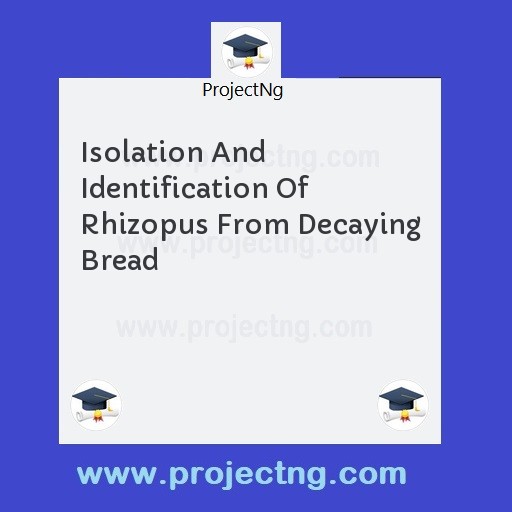Isolation And Identification Of Rhizopus From Decaying Bread
Science Lab Technology Project Topics
Get the Complete Project Materials Now! »
ISOLATION AND IDENTIFICATION OF RHIZOPUS FROM DECAYING BREAD
ABSTRACT
The Isolation and Identification of Rhizopus from a Decaying Bread were conducted. The black mould used in the practical was collected from bread. It is allowed to stay in moist environment or at room temperature for 2 to 3 days. The mould is then inoculated in the nutrient egar (N.A.) incubated and was isolated and view under the microscope for cultural characteristics.
In the experiment a mass of soft, closely woven white, silky threads was observed. In the microscope examination, non-deptate masses of round black spores, rhizoid. This characterized by Rhizopus SP.
In conclusion, since foodstuff from which the mould is isolated is bread, Rhizopus SP which is more prominent in bread than in any other foodstuff.
TABLE OF CONTENTS
Title page
Certification
Dedication
Acknowledgement
Abstract
Table of contents
CHAPTER ONE
INTRODUCTION
1.1 Aim and Objectives
1.2 Hypothesis
1.3 Statement of Problem
1.4 Significance of Study
1.5 Limitation of the Study
CHAPTER TWO
2.1 Composition of Bread and It’s Requirement
2.2 Source of Contamination
2.3 Rhizopus as a spoilage Organism
2.4 Physiological Characteristic of Rhizopus
2.5 Myeotoxins
2.6 Preservative
CHAPTER THREE
METHODOLOGY
3.1 Sample Collection
3.2 Direction for Method of preparation of the Medium
3.3 Isolation Method
3.4 Method of Identification
CHAPTER FOUR
GENERAL MORPHOLOGY
4.1 general Morphology of Rhizopus
4.2 Mode of Life
4.3 Reproduction of Rhizopus
CHPATER FIVE
RESULT
5.1 Table I
5.2 Table II
CHAPTER SIX
CONCLUSION AND RECOMMENDATION
6.1 Conclusion
6.2 Recommendation
REFERENCES
CHAPTER ONE
INTRODUCTION
Rhizopus nigricans belongs to a group of fungi known as the “black moulds”. It is also known commonly as the “read mould” because if grows freely on moist, state bread. It appears as a delicate black mass. It is a common mould, which is widespread in occurrence. Rhizopus forms a mass of soft, closely woven white silky threads. This mass, which is known as a mycelium is the vegetative part of the Fungs. Each silky thread like structure is a hypha. The ‘mycelium grows not only on the surface of the bread but into it as well. The bread is known as the substrate.
The mycelium consists of three sorts of hyphae. These three sorts of hyphae as stolons which grow horizontally on the substrate (bread), rhizoid or root like hyphae which arise at points where the stolons come into contact with the substrate and sport-angiophores. The rhizoids are much branched hyphae which penetrate into the substrate. They are able to digest and absorb organic food. The sporangiophores are erect unbranched hyphae arising from the stolons at the same points where rhizoids are formal.
They grow vertically upwards and give rise to the reproductive structures called sporangia. (Sargini et al, 1979).
The common bread mould (Rhizopus) finds new bakery items by means of air-born spores. Once the baked good is invaded, it won’t be long before black sporangia full of spores are formed. Rhizopus stolonifera (black mould) causes the black bread mould that forms cottony masses on the surface of moist
Be the First to Share On Social

Enjoying our content?
Don't miss out on new videos! Subscribe to our YouTube channel for more awesome content.
Subscribe Now!













